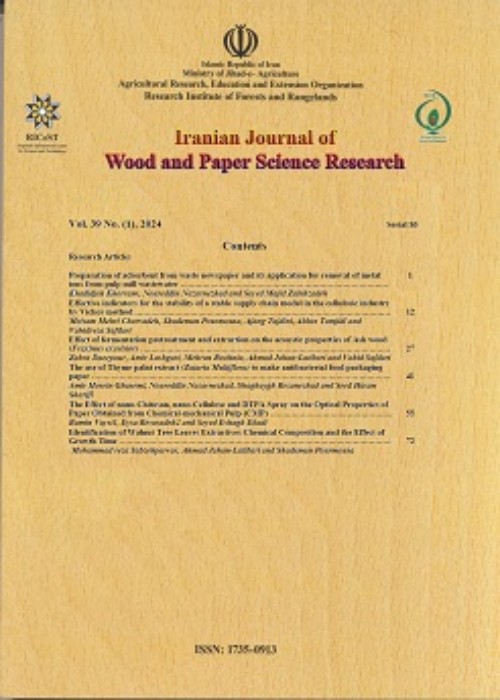The Effect of nano-Chitosan, nano-Cellulose and DTPA Spray on the Optical Properties of Paper Obtained from Chemical-mechanical Pulp (CMP)
Today, with the increase in population, increasing demand for paper, as well as greater restrictions on raw materials, the production of pulp from high-yield pulps and mechanical pulps has found a special place. These pulps have a high yield greater than 85%, but due to the presence of lignin, extracts, and metal ions, their use is limited to short-term usage, as in the long run they suffer from brightness reversion and photo-yellowing. This study aimed to investigate the effect of DTPA, nano-cellulose, and nano-chitosan spray on the optical properties of chemical-mechanical pulp (CMP).
For this purpose, first, a quantity of bleached chemical-mechanical pulp (CMP) was selected as a control sample from Mazandaran wood and paper industry. Papers with a base weight of 60 gr/m2 were prepared from the mentioned paper pulp. In this study, the nano-fibrillated cellulose (NFC) was purchased from Nano Novin Polymer Co. (Sari, Iran), which was prepared from softwood alpha cellulose pulp with an average fiber diameter of 32 nm. The NFC was loaded at 2% by spraying onto papersheets. Nanochitosan (“Seafresh”, Thailand), obtained from exoskeletons of crustaceans, with a deacetylation degree of 93% and a molecular weight of 270 kDa was used. Nanochitosan was loaded at 1 and 2% of the dry pulp weight. Diethylene triamine penta acetic acid (DTPA) was prepared from DIPER-Samchun (South Korea), with a 50% solid content and 25 cps viscosity. To spray the DTPA onto the paper surface, 0.5% DTPA was prepared. To prepare samples for the surface modification, paper sheets with a basis weight of 60 g/m2 were made. Then, 0.5% DTPA, 2% nanochitosan, and 2% nanocellulose were sprayed separately on the papersheets. In addition, another treatment named mixed-solution (containing 0.5 % DTPA + 2% nanochitosan + 2% nanocellulose) was sprayed onto the handsheets. The spraying time and distance were 20 s and 20 cm, respectively, and the treatment process was named “spray-coated”. Then, the optical properties (brightness, opacity, yellowness, and greenness) of the hand-sheets were measured according to ASTM and TAPPI standard methods.
The results showed that by DTPA, nano-cellulose, and nano-chitosan spray in the handsheet paper, brightness, yellowness, greenness, L* factor, and the opacity increased and the a* factor decreased. By spraying nano-cellulose on the test samples, most of the optical properties were significantly improved except for the yellowness of the hand-sheet paper. In addition, the most appropriate properties were observed in the paper obtained from DTPA spray and also in the simultaneous spray treatment of DTPA, nano-cellulose, and nano-chitosan on hand-sheet papers. Therefore, it has caused a very sensible increase and improvement in all the optical properties, which can be selected and suggested as the best treatment. The evaluation results of the brightness reversion of the hand-sheet paper from CMP pulp showed that most of the treatments led to a relative reduction of the return of the paper brightness. On the other hand, the lowest and highest brightness return values in the hand-sheet paper were obtained from 0.5% DTPA spray and nano-chitosan spray, respectively. The evaluation results of the SEM images of the test samples compared to the control sample showed that the hand-sheet paper with nano-chitosan and nano-cellulose spray and also in the simultaneous spray treatment of DTPA, nano-cellulose, and nano-chitosan had more favorable surface and structural properties. The existence of less empty spaces (cavity) and more overlap of fibers in the test samples can be a reason for the higher quality of the properties, as well.
The results showed that by spraying nanocellulose, nano- chitosan and DTPA on the test samples, the optical properties, brightness, greenness, opacity, a* factor, l* factor , yellowness and brightness durability improved. In addition, among the various treatments, the DTPA treatment in long-term thermal aging and the use of nano-chitosan and nano-cellulose in the short-term aging had noticeable effects on brightness durability and decrease in the color reversion. As a result, there was an increase in the durability of the paper against thermal deterioration.
- حق عضویت دریافتی صرف حمایت از نشریات عضو و نگهداری، تکمیل و توسعه مگیران میشود.
- پرداخت حق اشتراک و دانلود مقالات اجازه بازنشر آن در سایر رسانههای چاپی و دیجیتال را به کاربر نمیدهد.



